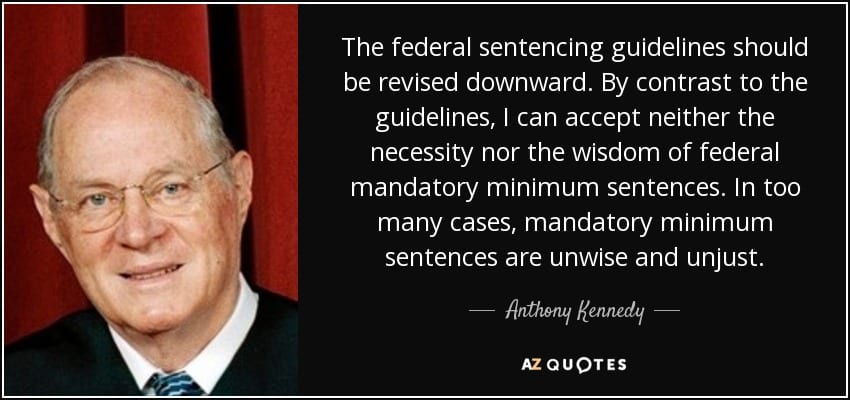US v. Diaz (2013 WL 322243) and US v. Hayes, 948 F.Supp.2d 1009 (2013): Two federal district judges disagree with the Federal Sentencing Guidelines policies regarding drug trafficking sentences.
These two important opinions offer thoughtful rebukes to the often draconian sentences imposed in federal court on defendants convicted of drug trafficking offenses.
First, Judge John Gleeson of the Eastern District of New York issued this Memorandum Explaining a Policy Disagreement with the Drug Trafficking Offense Guideline. Judge Gleeson was asked to sentence Ysidro Diaz, who was convicted of attempting to sell a kilogram of heroin to an undercover agent. Because of the weight and type of drug, he was charged to the mandatory minimum 10-year sentence dictated under the federal sentencing guidelines. Judge Gleeson has a fundamental policy disagreement with the length of imprisonment recommended by the United States Sentencing Commission’s Guidelines manual because it produces sentencing ranges that are “excessively severe.” He finds these guidelines to be “deeply and structurally flawed.”
The flaw is simply stated: the Guidelines ranges for drug trafficking offenses are not based on empirical data, Commission expertise, or the actual culpability of defendants. If they were, they would be much less severe, and judges would respect them more. Instead, they are driven by drug type and quantity, which are poor proxies for culpability.
Id. at 1.
The opinion fully fleshes out Judge Gleeson’s argument, but he provides a helpful roadmap at the beginning. His argument is essentially this:
- District Judges are authorized to disagree on policy grounds with the Guidelines;
- I disagree on policy grounds with the Guidelines range for drug trafficking offenses because they are not based on empirical data and national experience;
- Those ranges are excessively severe because they subject all drug trafficking defendants to the harsh weight-driven regime the ADAA (Anti -Drug Abuse Act of 1986, passed after Len Bias died of a drug overdose) intended only for managers and leaders of drug organizations;
- Those ranges are not now and have never been “heartland” sentences;
- The drug trafficking offense guideline has been a major contributor to the dramatic increase in the federal prison population;
- The Commission should “de-link” the drug trafficking Guidelines range from the ADAA’s weight-driven mandatory minimum sentences and use its resources,
- knowledge, and expertise to fashion fair sentencing ranges for drug trafficking offenses. In the meantime, it should reduce those ranges by a third;
- The Commission should make the drug trafficking offense guideline more sensitive to factors directly relevant to culpability, including the defendant’s role in the offense, and less sensitive to drug type and quantity;
- The Commission’s stated reasons for refusing to de-link the drug trafficking Guidelines ranges from the mandatory minimum sentences are wrong;
- The Commission should welcome (rather than seek to stifle as it currently does) policy disagreements expressed by sentencing judges;
- The federal judiciary has repeatedly told the Commission that the drug trafficking Guidelines ranges should be de-linked from the mandatory minimum sentences, and the Commission should stop ignoring that message;
- Whatever else it does or fails to do, the Commission should at least desist from its current practice of freighting the debate over adherence to the Guidelines with suggestions of racial disparity.
Judge Gleeson found that the fact that drug quantity is a poor proxy for culpability has been evident for two decades. A Department of Justice report in 1994 found that “[r]egardless of the functional role a defendant played in the drug scheme, the drug amounts involved in the offense are similar across the roles.” Therefore, defendants with very different roles–whether peripheral or central to the drug scheme, were receiving the same sentences. U.S. DEP’T OF JUSTICE, NAT’L INST. OF JUSTICE, AN ANALSYSIS OF NON-VIOLENT DRUG OFFENDERS WITH MINIMAL CRIMINAL HISTORIES 120 (1994).
Judge Mark Bennett of the Northern District of Iowa cited to Judge Gleeson’s opinion in U.S. Hayes. In Hayes, Bennett notes his policy disagreement with the guidelines applicable to methamphetamine. Noting that he has the authority to depart from the Guidelines based on policy disagreement, see e.g. Spears v. United States, 555 U.S. 261, 263-67 (2009) (per curiam), Kimbrough v. United States, 552 U.S. 85, 109-10 (2007), he proceeded to do so in this case. Judge Bennett shares nearly all of the same concerns voiced by Judge Gleeson, including, most notably, that drug weight is a very poor proxy for criminal culpability. Judge Bennett’s opinion also identifies some interesting, methamphetamine-specific facts. For example, in 2010, a mandatory minimum sentence applied in 83.1% of all methamphetamine cases, the highest rate of any drug type. More than 58% of these received some relief from the mandatory minimum at sentencing. Also no other drug is punished more severely based on purity, a fact that makes little empirical sense when you consider a courier or mule has no idea what the purity of the product may be. It makes no sense to sentence someone in that role more harshly than one moving around a lesser-pure product. Judge Bennett’s opinion also cites to a number of other decisions where federal district court judges have announced their policy disagreements with the drug trafficking guidelines, so practitioners should be aware that additional opinions abound. For practitioners representing federal clients on drug charges, these opinions offer thoughtful and important arguments that may benefit your client.

